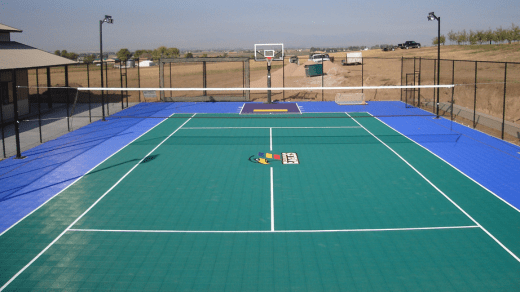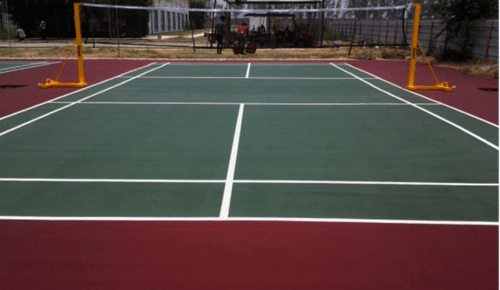Badminton is one of India’s most loved sports—popular among schoolchildren, professionals, and fitness enthusiasts alike. With growing demand for facilities in schools, clubs, housing societies, and sports academies, more and more developers are investing in building dedicated badminton courts. But one major decision often overlooked is the choice between indoor and outdoor badminton court flooring.
While both formats allow players to enjoy the game, their flooring systems differ significantly in materials, construction approach, and long-term performance. Whether you’re building a court for recreational play or training purposes, the choice of badminton court flooring can affect safety, playability, and maintenance in the long run.
In this blog, we’ll explore the key differences between indoor and outdoor badminton court flooring, the best material choices for each, and how to choose the right one based on your needs.
Understanding the Basics of Badminton Court Flooring
Before diving into indoor vs outdoor comparisons, it’s important to understand what badminton court flooring is expected to offer. The surface needs to provide:
- Proper grip and traction
- Shock absorption to protect joints
- Uniform bounce of the shuttle
- Weather and wear resistance
- Ease of maintenance
From acrylic systems to PU flooring and modular tiles, several material options exist—but the environment in which the court is placed will largely determine the most suitable choice.
Outdoor Badminton Court Flooring: Built for Indian Conditions
In outdoor settings like schools, parks, residential communities, and club spaces, courts are exposed to harsh weather—direct sunlight, rain, and dust. The flooring material used must be able to resist these elements without compromising on performance.
One of the most popular choices for outdoor is synthetic acrylic badminton court flooring in India. It’s engineered to handle UV exposure, moisture, and temperature variations while offering a non-slip, player-friendly surface.
Acrylic surfaces are layered over an asphalt or concrete base and come with customizable cushion systems for added comfort. The textured coating ensures good traction, while the bright color finish resists fading even in extreme weather.
For areas with heavy rain, courts can be designed with proper drainage and quick-dry coating systems, allowing play to resume shortly after rainfall. Another advantage of acrylic is its low maintenance—it doesn’t absorb water, grow moss, or become brittle under heat.
Indoor Badminton Court Surface: Precision and Comfort
Indoor badminton courts are typically built within gymnasiums, sports halls, or private arenas. Here, the flooring doesn’t have to battle with weather, but it must meet international standards of play, especially in competitive or training setups.
The most common indoor badminton court surface materials are PU (Polyurethane) and wooden flooring systems.
PU flooring is a synthetic option that offers excellent cushioning, anti-slip properties, and a uniform surface for high-speed rallies. It’s often chosen for multi-purpose sports halls where badminton, volleyball, and basketball may be played.
Wooden flooring, on the other hand, is traditionally favored for its superior shock absorption and high-end finish. However, it requires climate control to prevent warping or cracking due to humidity.
Indoor courts also demand proper lighting, ventilation, and space planning to accommodate professional gameplay. Since the surface doesn’t face environmental stress, aesthetics and performance take center stage in material selection.
Choosing Based on Use Case and Budget
The decision between outdoor and indoor badminton flooring options ultimately comes down to usage goals, space availability, and budget.
If your court is meant for:
- Recreational play in housing societies or schools
- Open spaces like parks or sports complexes
→ Go for: Synthetic acrylic outdoor badminton court flooring with weatherproof coatings
If your court is meant for:
- Professional training or competitive matches
- Institutions with indoor sports facilities
→ Go for: PU or wooden indoor badminton court surface with shock-absorbent properties
Acrylic surfaces are more cost-effective and require less upkeep, making them ideal for high-traffic public courts. PU and wood are premium options, preferred where indoor quality control and precision are top priorities.
Maintenance and Longevity
Maintenance is another key aspect to consider when selecting badminton court material. Outdoor courts need occasional cleaning, recoating, and minor surface repair—especially in high-use facilities. However, their acrylic coatings are designed to last 5–7 years with basic upkeep.
Indoor courts, particularly wooden ones, demand climate regulation and regular polishing. PU flooring is relatively easier to maintain but may require surface recoating depending on wear.
In both cases, choosing certified, professional-grade materials ensures that your court retains its quality for years while reducing downtime due to repairs.
Final Thoughts
There’s no one-size-fits-all answer in the debate between indoor and outdoor badminton court flooring. Both have unique advantages and are suited to different needs. Choose outdoor acrylic systems if you need durability, affordability, and minimal upkeep in open-air conditions. And PU or wood for indoor use where game quality, bounce, and joint comfort matter most.
With India’s rising sports infrastructure demands, investing in the right flooring ensures safety, better playability, and higher ROI—whether it’s for a community facility, a school, or a private sports academy.




